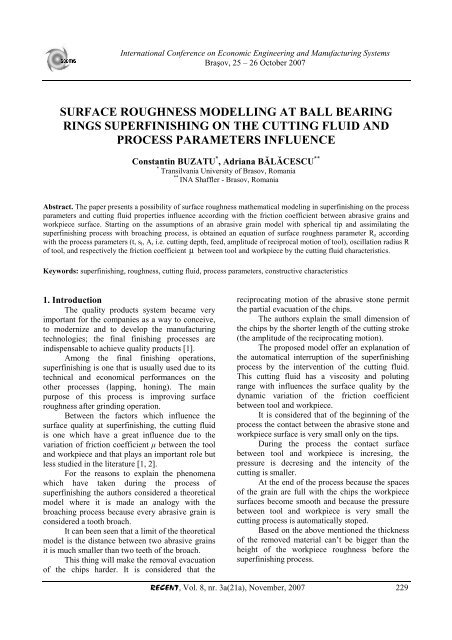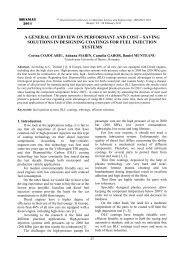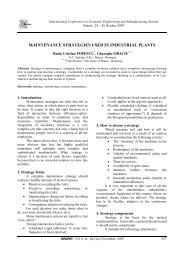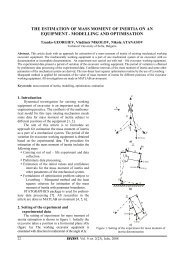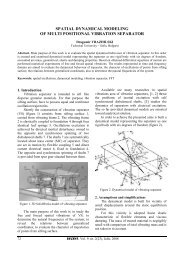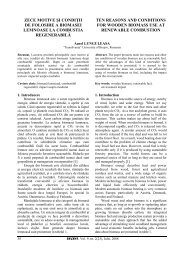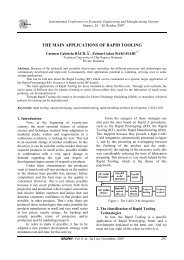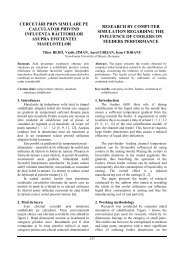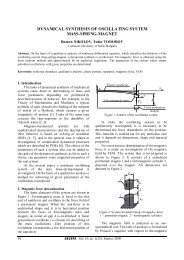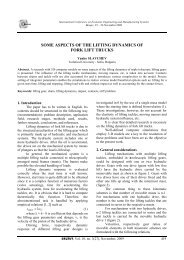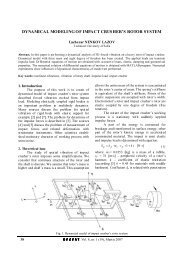surface roughness modelling at ball bearing rings superfinishing on ...
surface roughness modelling at ball bearing rings superfinishing on ...
surface roughness modelling at ball bearing rings superfinishing on ...
Create successful ePaper yourself
Turn your PDF publications into a flip-book with our unique Google optimized e-Paper software.
Intern<str<strong>on</strong>g>at</str<strong>on</strong>g>i<strong>on</strong>al C<strong>on</strong>ference <strong>on</strong> Ec<strong>on</strong>omic Engineering and Manufacturing Systems<br />
Braşov, 25 – 26 October 2007<br />
SURFACE ROUGHNESS MODELLING AT BALL BEARING<br />
RINGS SUPERFINISHING ON THE CUTTING FLUID AND<br />
PROCESS PARAMETERS INFLUENCE<br />
C<strong>on</strong>stantin BUZATU * , Adriana BĂLĂCESCU **<br />
* Transilvania University of Brasov, Romania<br />
**<br />
INA Shaffler - Brasov, Romania<br />
Abstract. The paper presents a possibility of <str<strong>on</strong>g>surface</str<strong>on</strong>g> <str<strong>on</strong>g>roughness</str<strong>on</strong>g> m<str<strong>on</strong>g>at</str<strong>on</strong>g>hem<str<strong>on</strong>g>at</str<strong>on</strong>g>ical modeling in <str<strong>on</strong>g>superfinishing</str<strong>on</strong>g> <strong>on</strong> the process<br />
parameters and cutting fluid properties influence according with the fricti<strong>on</strong> coefficient between abrasive grains and<br />
workpiece <str<strong>on</strong>g>surface</str<strong>on</strong>g>. Starting <strong>on</strong> the assumpti<strong>on</strong>s of an abrasive grain model with spherical tip and assimil<str<strong>on</strong>g>at</str<strong>on</strong>g>ing the<br />
<str<strong>on</strong>g>superfinishing</str<strong>on</strong>g> process with broaching process, is obtained an equ<str<strong>on</strong>g>at</str<strong>on</strong>g>i<strong>on</strong> of <str<strong>on</strong>g>surface</str<strong>on</strong>g> <str<strong>on</strong>g>roughness</str<strong>on</strong>g> parameter R z according<br />
with the process parameters (t, s l , A, i.e. cutting depth, feed, amplitude of reciprocal moti<strong>on</strong> of tool), oscill<str<strong>on</strong>g>at</str<strong>on</strong>g>i<strong>on</strong> radius R<br />
of tool, and respectively the fricti<strong>on</strong> coefficient µ between tool and workpiece by the cutting fluid characteristics.<br />
Keywords: <str<strong>on</strong>g>superfinishing</str<strong>on</strong>g>, <str<strong>on</strong>g>roughness</str<strong>on</strong>g>, cutting fluid, process parameters, c<strong>on</strong>structive characteristics<br />
1. Introducti<strong>on</strong><br />
The quality products system became very<br />
important for the companies as a way to c<strong>on</strong>ceive,<br />
to modernize and to develop the manufacturing<br />
technologies; the final finishing processes are<br />
indispensable to achieve quality products [1].<br />
Am<strong>on</strong>g the final finishing oper<str<strong>on</strong>g>at</str<strong>on</strong>g>i<strong>on</strong>s,<br />
<str<strong>on</strong>g>superfinishing</str<strong>on</strong>g> is <strong>on</strong>e th<str<strong>on</strong>g>at</str<strong>on</strong>g> is usually used due to its<br />
technical and ec<strong>on</strong>omical performances <strong>on</strong> the<br />
other processes (lapping, h<strong>on</strong>ing). The main<br />
purpose of this process is improving <str<strong>on</strong>g>surface</str<strong>on</strong>g><br />
<str<strong>on</strong>g>roughness</str<strong>on</strong>g> after grinding oper<str<strong>on</strong>g>at</str<strong>on</strong>g>i<strong>on</strong>.<br />
Between the factors which influence the<br />
<str<strong>on</strong>g>surface</str<strong>on</strong>g> quality <str<strong>on</strong>g>at</str<strong>on</strong>g> <str<strong>on</strong>g>superfinishing</str<strong>on</strong>g>, the cutting fluid<br />
is <strong>on</strong>e which have a gre<str<strong>on</strong>g>at</str<strong>on</strong>g> influence due to the<br />
vari<str<strong>on</strong>g>at</str<strong>on</strong>g>i<strong>on</strong> of fricti<strong>on</strong> coefficient µ between the tool<br />
and workpiece and th<str<strong>on</strong>g>at</str<strong>on</strong>g> plays an important role but<br />
less studied in the liter<str<strong>on</strong>g>at</str<strong>on</strong>g>ure [1, 2].<br />
For the reas<strong>on</strong>s to explain the phenomena<br />
which have taken during the process of<br />
<str<strong>on</strong>g>superfinishing</str<strong>on</strong>g> the authors c<strong>on</strong>sidered a theoretical<br />
model where it is made an analogy with the<br />
broaching process because every abrasive grain is<br />
c<strong>on</strong>sidered a tooth broach.<br />
It can been seen th<str<strong>on</strong>g>at</str<strong>on</strong>g> a limit of the theoretical<br />
model is the distance between two abrasive grains<br />
it is much smaller than two teeth of the broach.<br />
This thing will make the removal evacu<str<strong>on</strong>g>at</str<strong>on</strong>g>i<strong>on</strong><br />
of the chips harder. It is c<strong>on</strong>sidered th<str<strong>on</strong>g>at</str<strong>on</strong>g> the<br />
reciproc<str<strong>on</strong>g>at</str<strong>on</strong>g>ing moti<strong>on</strong> of the abrasive st<strong>on</strong>e permit<br />
the partial evacu<str<strong>on</strong>g>at</str<strong>on</strong>g>i<strong>on</strong> of the chips.<br />
The authors explain the small dimensi<strong>on</strong> of<br />
the chips by the shorter length of the cutting stroke<br />
(the amplitude of the reciproc<str<strong>on</strong>g>at</str<strong>on</strong>g>ing moti<strong>on</strong>).<br />
The proposed model offer an explan<str<strong>on</strong>g>at</str<strong>on</strong>g>i<strong>on</strong> of<br />
the autom<str<strong>on</strong>g>at</str<strong>on</strong>g>ical interrupti<strong>on</strong> of the <str<strong>on</strong>g>superfinishing</str<strong>on</strong>g><br />
process by the interventi<strong>on</strong> of the cutting fluid.<br />
This cutting fluid has a viscosity and poluting<br />
range with influences the <str<strong>on</strong>g>surface</str<strong>on</strong>g> quality by the<br />
dynamic vari<str<strong>on</strong>g>at</str<strong>on</strong>g>i<strong>on</strong> of the fricti<strong>on</strong> coefficient<br />
between tool and workpiece.<br />
It is c<strong>on</strong>sidered th<str<strong>on</strong>g>at</str<strong>on</strong>g> of the beginning of the<br />
process the c<strong>on</strong>tact between the abrasive st<strong>on</strong>e and<br />
workpiece <str<strong>on</strong>g>surface</str<strong>on</strong>g> is very small <strong>on</strong>ly <strong>on</strong> the tips.<br />
During the process the c<strong>on</strong>tact <str<strong>on</strong>g>surface</str<strong>on</strong>g><br />
between tool and workpiece is incresing, the<br />
pressure is decresing and the intencity of the<br />
cutting is smaller.<br />
At the end of the process because the spaces<br />
of the grain are full with the chips the workpiece<br />
<str<strong>on</strong>g>surface</str<strong>on</strong>g>s become smooth and because the pressure<br />
between tool and workpiece is very small the<br />
cutting process is autom<str<strong>on</strong>g>at</str<strong>on</strong>g>ically stoped.<br />
Based <strong>on</strong> the above menti<strong>on</strong>ed the thickness<br />
of the removed m<str<strong>on</strong>g>at</str<strong>on</strong>g>erial can’t be bigger than the<br />
height of the workpiece <str<strong>on</strong>g>roughness</str<strong>on</strong>g> before the<br />
<str<strong>on</strong>g>superfinishing</str<strong>on</strong>g> process.<br />
RECENT, Vol. 8, nr. 3a(21a), November, 2007 229
Surface Roughness Modelling <str<strong>on</strong>g>at</str<strong>on</strong>g> Ball Bearing Rings Superfinishing <strong>on</strong> the Cutting Fluid and Process …<br />
Comparing with other theoretical models <str<strong>on</strong>g>at</str<strong>on</strong>g><br />
machining this model <str<strong>on</strong>g>at</str<strong>on</strong>g> <str<strong>on</strong>g>superfinishing</str<strong>on</strong>g> take into<br />
account the influence of the cutting liquid as an<br />
active elemnt in the c<strong>on</strong>tact z<strong>on</strong>e between abrasive<br />
tool and workpiece <str<strong>on</strong>g>surface</str<strong>on</strong>g>.<br />
This cutting liquid made by oil and petrol<br />
has an important role in the interrupti<strong>on</strong> of the<br />
cutting process after a time wich is dependent by<br />
the fricti<strong>on</strong> coefficient between the tool and<br />
workpiece.<br />
Starting <strong>on</strong> these c<strong>on</strong>sider<str<strong>on</strong>g>at</str<strong>on</strong>g>i<strong>on</strong>s it will be<br />
shown a new approach of <str<strong>on</strong>g>surface</str<strong>on</strong>g> <str<strong>on</strong>g>roughness</str<strong>on</strong>g><br />
modeling <str<strong>on</strong>g>at</str<strong>on</strong>g> <str<strong>on</strong>g>superfinishing</str<strong>on</strong>g> th<str<strong>on</strong>g>at</str<strong>on</strong>g> will take into<br />
c<strong>on</strong>sider<str<strong>on</strong>g>at</str<strong>on</strong>g>i<strong>on</strong> also the cutting fluid.<br />
2. Surface <str<strong>on</strong>g>roughness</str<strong>on</strong>g> modeling <str<strong>on</strong>g>at</str<strong>on</strong>g><br />
<str<strong>on</strong>g>superfinishing</str<strong>on</strong>g><br />
The theoretical analysis of a machining<br />
process requires to make a physical model, an ideal<br />
approxim<str<strong>on</strong>g>at</str<strong>on</strong>g>i<strong>on</strong> of reality, which reflects the<br />
principle based <strong>on</strong> some assumpti<strong>on</strong>s.<br />
This physical model has to carry out the<br />
essential c<strong>on</strong>diti<strong>on</strong>s of each model:<br />
- to be very simple;<br />
- to represent the essence of the process.<br />
The theoretical model of abrasive machining<br />
taking into account <strong>on</strong>e grain [8] was made without<br />
the influence of the cutting liquid. All the studies<br />
referred to fricti<strong>on</strong>, shearing and dry removing<br />
between the abrasive grain and workpiece m<str<strong>on</strong>g>at</str<strong>on</strong>g>erial.<br />
For these reas<strong>on</strong>s, a theoretical model <str<strong>on</strong>g>at</str<strong>on</strong>g> abrasi<strong>on</strong><br />
by <str<strong>on</strong>g>superfinishing</str<strong>on</strong>g> have to be d<strong>on</strong>e with the<br />
influence and characteristics of the cutting liquid:<br />
- The machining z<strong>on</strong>e which includes chip and<br />
adjacent z<strong>on</strong>e are “sinking” in an envir<strong>on</strong>ment<br />
of <str<strong>on</strong>g>superfinishing</str<strong>on</strong>g> fluid which c<strong>on</strong>sists of petrol<br />
and oil. The liquid drops have the dimensi<strong>on</strong>s<br />
in a renge of 0.1-1 µm and can be approxim<str<strong>on</strong>g>at</str<strong>on</strong>g>e<br />
to a small <str<strong>on</strong>g>ball</str<strong>on</strong>g>s;<br />
- In <str<strong>on</strong>g>superfinishing</str<strong>on</strong>g> process the liquid drops<br />
adhere to the workpiece <str<strong>on</strong>g>surface</str<strong>on</strong>g> and abrasive<br />
tool making a layer with active role in the<br />
cutting forces balance. Through this layer the<br />
dry fricti<strong>on</strong> between the grain and workpiece is<br />
replaced by the wet fricti<strong>on</strong>, which means a<br />
gre<str<strong>on</strong>g>at</str<strong>on</strong>g> reducti<strong>on</strong> of fricti<strong>on</strong> coefficient, of the<br />
cutting forces and the he<str<strong>on</strong>g>at</str<strong>on</strong>g> th<str<strong>on</strong>g>at</str<strong>on</strong>g> appears in the<br />
process;<br />
- The cutting liquid drops are found in the same<br />
range of the chip <str<strong>on</strong>g>surface</str<strong>on</strong>g> and in the mass of<br />
liquid leading to a variable fricti<strong>on</strong> coefficient<br />
in the process;<br />
- During the <str<strong>on</strong>g>superfinishing</str<strong>on</strong>g> process the he<str<strong>on</strong>g>at</str<strong>on</strong>g> th<str<strong>on</strong>g>at</str<strong>on</strong>g><br />
is gener<str<strong>on</strong>g>at</str<strong>on</strong>g>ed is a small value, and the cutting<br />
liquid has a small capacity of cooling and a<br />
bigger capacity of lubric<str<strong>on</strong>g>at</str<strong>on</strong>g>i<strong>on</strong>;<br />
- The reducti<strong>on</strong> of fricti<strong>on</strong> between the tool and<br />
workpiece <str<strong>on</strong>g>surface</str<strong>on</strong>g> d<strong>on</strong>’t cancel the fricti<strong>on</strong><br />
forces, and based <strong>on</strong> some tests [7] it is shows<br />
the influence of the fricti<strong>on</strong> coefficient<br />
between tool and workpiece <strong>on</strong> the <str<strong>on</strong>g>surface</str<strong>on</strong>g><br />
finish.<br />
To make m<str<strong>on</strong>g>at</str<strong>on</strong>g>hem<str<strong>on</strong>g>at</str<strong>on</strong>g>ical <str<strong>on</strong>g>modelling</str<strong>on</strong>g> of <str<strong>on</strong>g>surface</str<strong>on</strong>g><br />
<str<strong>on</strong>g>roughness</str<strong>on</strong>g> <str<strong>on</strong>g>at</str<strong>on</strong>g> <str<strong>on</strong>g>superfinishing</str<strong>on</strong>g> will start from next<br />
initial assumpti<strong>on</strong>s:<br />
- it is c<strong>on</strong>sidering the model of the abrasive grain<br />
with spherical tip [3], th<str<strong>on</strong>g>at</str<strong>on</strong>g> is unanimous accepted<br />
in the liter<str<strong>on</strong>g>at</str<strong>on</strong>g>ure (figure 1);<br />
- <strong>on</strong> the point of view of removing chips, it is<br />
assimil<str<strong>on</strong>g>at</str<strong>on</strong>g>e <str<strong>on</strong>g>superfinishing</str<strong>on</strong>g> with broaching;<br />
The abrasive grain, with c<strong>on</strong>e angle β, has<br />
the free height h g , bottom width b, top radius r<br />
(obtained by wearing during machining process),<br />
e – the distance between grains, α and γ being the<br />
rake and relief angles of the grain.<br />
According with the initial assumpti<strong>on</strong>s and<br />
with those presented in the paper [4], was deducted<br />
th<str<strong>on</strong>g>at</str<strong>on</strong>g> the height of <str<strong>on</strong>g>surface</str<strong>on</strong>g> <str<strong>on</strong>g>roughness</str<strong>on</strong>g> (R z criteri<strong>on</strong>) it<br />
is obtained with a good approxim<str<strong>on</strong>g>at</str<strong>on</strong>g>e from the<br />
equ<str<strong>on</strong>g>at</str<strong>on</strong>g>i<strong>on</strong>:<br />
Rz<br />
≅ tg<br />
max ⋅ tgα<br />
(1)<br />
where t gmax is maximum thickness of cutting <strong>on</strong> the<br />
abrasive grain, and α is the rake angle of grain.<br />
If is taking into account th<str<strong>on</strong>g>at</str<strong>on</strong>g> chip side area A l<br />
removed by <strong>on</strong>e abrasive grain is given by the next<br />
equ<str<strong>on</strong>g>at</str<strong>on</strong>g>i<strong>on</strong> (see figure 1):<br />
hg<br />
⋅ e<br />
A = k ⋅ A ⋅ t ≅ , (2)<br />
l<br />
1<br />
g max<br />
2<br />
where, A is amplitude of tool reciprocal moti<strong>on</strong>,<br />
and k 1 is the coefficient taking into account th<str<strong>on</strong>g>at</str<strong>on</strong>g> a<br />
small number of grains works <str<strong>on</strong>g>at</str<strong>on</strong>g> maximum<br />
capacity (those of roughing), the rest of them<br />
having the role of calibr<str<strong>on</strong>g>at</str<strong>on</strong>g>ing of <str<strong>on</strong>g>surface</str<strong>on</strong>g>.<br />
230 RECENT, Vol. 8, nr. 3a(21a), November, 2007
Surface Roughness Modelling <str<strong>on</strong>g>at</str<strong>on</strong>g> Ball Bearing Rings Superfinishing <strong>on</strong> the Cutting Fluid and Process …<br />
b<strong>on</strong>d<br />
grain<br />
Figure 2. The spherical model of grain <str<strong>on</strong>g>at</str<strong>on</strong>g> machining with abrasives<br />
C<strong>on</strong>sidering the c<strong>on</strong>diti<strong>on</strong> of grain moti<strong>on</strong><br />
without sliding [5]:<br />
α ≤ arctgµ,<br />
(3)<br />
from the equ<str<strong>on</strong>g>at</str<strong>on</strong>g>i<strong>on</strong>s (1)÷(3), results:<br />
hg<br />
⋅ e ⋅µ<br />
Rz<br />
≅ (4)<br />
2Ak 1<br />
Assimil<str<strong>on</strong>g>at</str<strong>on</strong>g>ing <str<strong>on</strong>g>superfinishing</str<strong>on</strong>g> with broaching<br />
(as is removed the chips), the structure of the<br />
abrasive tool is essential to provide clearance for<br />
the chips.<br />
It results th<str<strong>on</strong>g>at</str<strong>on</strong>g> the grain c<strong>on</strong>structive<br />
parameters h g and e (figure 1) must to have the<br />
next c<strong>on</strong>diti<strong>on</strong>s from the broaching tool [6]:<br />
e ≈ p = ( 1.25 −1.5)<br />
A,<br />
(5)<br />
where p is grain pitch, and<br />
h g ≅ h = 1.13⋅<br />
k ⋅ a g max ⋅ A , (6)<br />
where k is a coefficient which depends of the<br />
chipshape.<br />
Taking into account th<str<strong>on</strong>g>at</str<strong>on</strong>g> the maximum chip<br />
thickness <str<strong>on</strong>g>at</str<strong>on</strong>g> <str<strong>on</strong>g>superfinishing</str<strong>on</strong>g> is given by the equ<str<strong>on</strong>g>at</str<strong>on</strong>g>i<strong>on</strong><br />
[3]:<br />
t<br />
ag<br />
max = 2 ⋅ sg<br />
⋅ ,<br />
(7)<br />
R<br />
where s g is the feed <strong>on</strong> the grain, t is the depth of<br />
cut, R is the oscill<str<strong>on</strong>g>at</str<strong>on</strong>g>i<strong>on</strong> radius of abrasive tool,<br />
results from the equ<str<strong>on</strong>g>at</str<strong>on</strong>g>i<strong>on</strong>s (4)÷(7):<br />
µ 2t<br />
Rz<br />
≈ (0,7 − 0,85) k ⋅ sg<br />
⋅ , (8)<br />
k1 R<br />
Feed <strong>on</strong> the abrasive grain s g is given by the<br />
equ<str<strong>on</strong>g>at</str<strong>on</strong>g>i<strong>on</strong>:<br />
s<br />
S l<br />
g = ,<br />
(9)<br />
Ng<br />
where s l is the tool feed, and N g is the grain<br />
numbers which works <strong>on</strong> the p<str<strong>on</strong>g>at</str<strong>on</strong>g>h equal with the<br />
amplitude of moti<strong>on</strong>:<br />
A<br />
A<br />
N g = = , (10)<br />
(1.25...1.5) A (1.25...1.5)<br />
If is replacing equ<str<strong>on</strong>g>at</str<strong>on</strong>g>i<strong>on</strong>s (9) and (10) in the<br />
equ<str<strong>on</strong>g>at</str<strong>on</strong>g>i<strong>on</strong> (8) is obtained finally:<br />
(0,7 − 0,8) µ<br />
2t<br />
Rz<br />
= (1,25 −1,5)<br />
k ⋅ sl<br />
⋅ , (11)<br />
k1 R ⋅ A<br />
which shows process parameters, t, s l , A,<br />
oscill<str<strong>on</strong>g>at</str<strong>on</strong>g>i<strong>on</strong> radius R of abrasive tool, and the<br />
fricti<strong>on</strong> coefficient µ between tool and workpiece<br />
by the cutting fluid.<br />
3. C<strong>on</strong>clusi<strong>on</strong>s<br />
Based <strong>on</strong> the previous presented the next<br />
c<strong>on</strong>clusi<strong>on</strong>s appear:<br />
1) The m<str<strong>on</strong>g>at</str<strong>on</strong>g>hem<str<strong>on</strong>g>at</str<strong>on</strong>g>ical modeling of <str<strong>on</strong>g>surface</str<strong>on</strong>g><br />
<str<strong>on</strong>g>roughness</str<strong>on</strong>g> <str<strong>on</strong>g>at</str<strong>on</strong>g> <str<strong>on</strong>g>superfinishing</str<strong>on</strong>g> taking into account<br />
the spherical model of abrasive grain and the<br />
similitude with the broaching process, is<br />
RECENT, Vol. 8, nr. 3a(21a), November, 2007 231
Surface Roughness Modelling <str<strong>on</strong>g>at</str<strong>on</strong>g> Ball Bearing Rings Superfinishing <strong>on</strong> the Cutting Fluid and Process …<br />
finding the <str<strong>on</strong>g>surface</str<strong>on</strong>g> <str<strong>on</strong>g>roughness</str<strong>on</strong>g> after the<br />
influence of many factors of machining:<br />
process parameters and cutting fluid;<br />
2) The influence of the cutting fluid <strong>on</strong> the <str<strong>on</strong>g>surface</str<strong>on</strong>g><br />
finish through the fricti<strong>on</strong> coefficient µ is<br />
proporti<strong>on</strong>al type, according with the<br />
experimental tests <str<strong>on</strong>g>at</str<strong>on</strong>g> machining the <str<strong>on</strong>g>ball</str<strong>on</strong>g><br />
<str<strong>on</strong>g>bearing</str<strong>on</strong>g> <str<strong>on</strong>g>rings</str<strong>on</strong>g> [7].<br />
3) The influence of the fricti<strong>on</strong> coefficient between<br />
the tool and workpiece <str<strong>on</strong>g>surface</str<strong>on</strong>g> impose a<br />
careful <str<strong>on</strong>g>at</str<strong>on</strong>g>tenti<strong>on</strong> when is chosen the cutting<br />
fluid.<br />
4) The optomiz<str<strong>on</strong>g>at</str<strong>on</strong>g>i<strong>on</strong> of <str<strong>on</strong>g>superfinishing</str<strong>on</strong>g> process<br />
impose a multicriteri<strong>on</strong> approach of the factors<br />
th<str<strong>on</strong>g>at</str<strong>on</strong>g> influence the <str<strong>on</strong>g>surface</str<strong>on</strong>g> quality: c<strong>on</strong>structive<br />
parameters of the tool, technological<br />
parameters, properties and characteristics of<br />
the cutting fluid.<br />
5) The modell of <str<strong>on</strong>g>superfinishing</str<strong>on</strong>g> process can br use<br />
also to the others finishing processes: h<strong>on</strong>ing,<br />
lapping, polishing.<br />
4. References<br />
1. Buz<str<strong>on</strong>g>at</str<strong>on</strong>g>u, C., Piukovici, I., Nedelcu, A., Lepădătescu, B.:<br />
Finishing processes of the <str<strong>on</strong>g>surface</str<strong>on</strong>g>s in engineering. Lux<br />
Libris Publishing, ISBN 973-9240-47-X, Braşov,<br />
Romania, 1998 (in Romanian)<br />
2. Buz<str<strong>on</strong>g>at</str<strong>on</strong>g>u, C.: Manufacturing technologies in engineering.<br />
“Transilvania” University Press, ISBN 973-635-238-2,<br />
Braşov, Romania, 2003 (in Romanian)<br />
3. Crăciunoiu, N.: Researches regarding design and new<br />
technologies for <str<strong>on</strong>g>superfinishing</str<strong>on</strong>g> to carbide inserts. PhD<br />
Thesis, University of Craiova, Romania, 1997 (in<br />
Romanian)<br />
4. Buz<str<strong>on</strong>g>at</str<strong>on</strong>g>u, C., Draghici, G., Secară, G., Roşca, D.: Surface<br />
quality <str<strong>on</strong>g>at</str<strong>on</strong>g> broaching and the influence of various factors<br />
<strong>on</strong> it. Scientific Bulletin of “Transilvania” University of<br />
Brasov, Seria A, vol. XXI-C-1979, Braşov, Romania,<br />
p. 35 - 40 (in Romanian)<br />
5. Buz<str<strong>on</strong>g>at</str<strong>on</strong>g>u, C.: Autom<str<strong>on</strong>g>at</str<strong>on</strong>g>i<strong>on</strong> and robotics in manufacturing<br />
processes. “Transilvania” University Press, 1988 (in<br />
Romanian)<br />
6. Lăzărescu, I.: Calcul<str<strong>on</strong>g>at</str<strong>on</strong>g>i<strong>on</strong> and c<strong>on</strong>structi<strong>on</strong> of cutting tools.<br />
“Tehnică” Publishing House, Bucharest, Romania, 1961<br />
(in Romanian)<br />
7. Lepădătescu, B., Sim<strong>on</strong>, E.A., Mareş, G.: Surface<br />
technology. “Transilvania” University Press, ISBN 973-<br />
635-390-7, Braşov, Romania, 2005 (in Romanian)<br />
8. Roşca, D.M.: Abrasive tools. “Lux Libris” Publishing<br />
House, Braşov, Romania, 1995 (in Romanian)<br />
232 RECENT, Vol. 8, nr. 3a(21a), November, 2007


